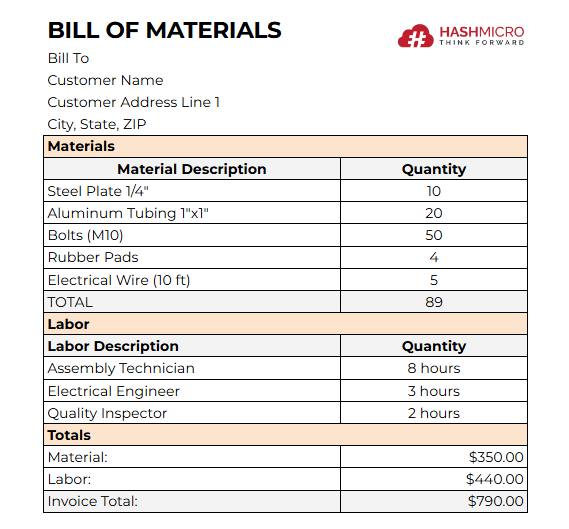A Bill of Materials (BOM)template is a detailed list of components, materials, and parts required to manufacture a product. It serves as a blueprint for production, containing all the essential information about each component’s quantity, specifications, and sources.
With the global BOM software market projected to grow from $8.56 billion in 2023 to $11.71 billion by 2028 (CAGR of 6.5%), adopting a robust manufacturing system is essential for businesses looking to stay competitive and streamline production processes.
Using an efficient manufacturing system can simplify the creation and management of BOMs. With a structured bill of material template, manufacturers can save time, reduce errors, and achieve greater control over inventory.
This article explores how structured bill of material templates can simplify manufacturing processes. By providing examples of effective templates, we aim to help manufacturers streamline BOM management, save time, and reduce production errors.
Table of Content:
Table of Content

Key Takeaways
|
What is a Bill of Material
A Bill of Material (BOM) Template lists all components, materials, and quantities required to build a product. It helps streamline production by organizing details like item names, specifications, and suppliers, ensuring accurate and efficient manufacturing.
The Bill of material template serves as a master reference, enabling everyone from procurement to assembly teams to understand the product structure clearly. This central source of information ensures that nothing is missed in the production process.
A well-designed Bill of Material (BOM) template also helps minimize errors, reduce waste, and improve production timelines. It can be customized to meet a business’s specific needs or adapted to a product’s complexity, making it valuable for manufacturing facilities.
In this way, a bill of material template simplifies production and enhances cost management, allowing manufacturers to monitor and plan resource allocation effectively.
Benefits of Bill of Materials Template for Business
A Bill of Materials (BOM) Template offers several key benefits that can significantly enhance business operations, particularly for manufacturers and product developers. Here are the main advantages of implementing a BOM template for your business:
1. Improved accuracy and consistency
A well-organized BOM template ensures that all components and materials required for production are clearly outlined. By eliminating manual tracking or reliance on inconsistent documentation, businesses can reduce errors, ensuring the right materials are available when needed.
2. Cost control and resource management
With a detailed BOM template, businesses can easily track the quantity and cost of each component needed for production. This allows companies to manage inventory better, avoid material shortages, and reduce excess purchasing.
3. Streamlined communication and collaboration
A BOM template acts as a central reference point for all teams involved in the manufacturing process, from procurement to assembly and quality control. This streamlined communication reduces misunderstandings and helps departments stay aligned on the production requirements.
4. Faster production and reduced lead times
By using a BOM template, businesses can speed up the production process by ensuring all necessary materials and components are available in the right quantities. This reduces lead times and enhances production efficiency.
5. Scalability and flexibility
As businesses grow, their production needs often become more complex. A flexible BOM template can be adapted to suit the increasing scale of operations and product diversity.
By adopting this structured approach, companies can ensure smoother operations and a more streamlined path from concept to finished product.
What to Include in a Bill of Materials
A well-structured Bill of Materials (BOM) ensures that all components and materials required for production are accurately tracked. While the details may vary depending on the product, the following key elements should always be included in your BOM:
- Item name and description: Clear labeling of each component with a concise description to ensure easy identification during production.
- Part numbers: Each component or material needs a unique part number. This number acts as a reference code and makes it easier to track, order, and manage components.
- Quantities: The BOM should include the exact number of each part or material needed for production. This helps prevent over-ordering or under-ordering, which can lead to excess inventory or production delays.
- Unit of Measure (UOM): Clearly define the unit of measure (e.g., pieces, kilograms, meters, etc.) for each part or material listed in the BOM.
- Supplier information: Contact details for preferred suppliers of each component to facilitate procurement and ensure consistency.
- Cost per unit: Include the cost for each material or component in the BOM to help track expenses. This supports financial planning and helps in pricing the final product.
- Assembly instructions: Detailed steps or references for assembling the components correctly, ensuring efficiency and accuracy in production.
- Revision and version control: This process tracks any changes or updates to components, ensuring the latest version is used during production.
- Lead time: The time required for suppliers to deliver materials, helping in planning and avoiding delays in production schedules.
Including these elements in your BOM ensures a smooth, efficient, and cost-effective manufacturing process, with minimal errors and better resource management.
How to Create a Bill of Materials Template
Creating a Bill of Materials (BOM) Template is essential in organizing and streamlining your manufacturing process. Here’s a step-by-step guide on how to create an effective BOM template:
1. Choose the right format
The first step in creating a BOM template is deciding on the format. Most companies use spreadsheets (Excel or Google Sheets) because they offer flexibility and are easy to customize. You can also opt for specialized software or systems designed for BOM management, which often include additional features
2. Define the key columns
A well-structured Bill of Materials (BOM) template typically includes essential elements such as item names, part numbers, quantities, unit of measure, supplier information, cost per unit, assembly instructions, lead time, and revision/version details.
3. Use clear and consistent naming conventions
Use clear and consistent naming conventions throughout your BOM template to avoid confusion. For example, use standardized terminology for materials, parts, and components, and make sure that part numbers follow a consistent format.
4. Include detailed descriptions and specifications
While the part name is essential, the description and specifications of each item are equally crucial. These details can include the material type, dimensions, colour, or other technical information defining the part.
5. Set up version control
As your product design evolves, it’s essential to maintain version control for your BOM template. This allows you to track changes and ensure all stakeholders use the most up-to-date information.
6. Integrate with other systems
Integrate your BOM template with other software systems you use, such as inventory management, procurement, or production planning tools. This integration allows for real-time updates and reduces the need for manual data entry.
Following these steps, you can create a comprehensive and practical Bill of Materials template that will help streamline your production process, improve communication, and ensure consistency across all manufacturing stages.
You can also read our article on the best manufacturing systems to discover more solutions that can optimize your production process and enhance efficiency.
Challenges of Using a Bill of Materials Template
While a Bill of Materials (BOM) template is an essential tool for managing production processes, it has its challenges. Businesses may need help with implementing and maintaining a BOM template. Below are some common challenges organizations face:
1. Complexity and maintenance
As products become more complex, the bill of material template can become increasingly difficult to manage. Large products with multiple components and variations may require frequent updates to ensure accuracy.
2. Data accuracy and consistency
A significant challenge with BOM templates is ensuring data accuracy and consistency across the organization. Part numbers, quantities, or supplier information errors can lead to production delays, procurement issues, and increased costs.
3. Lack of integration with other systems
Many businesses struggle to integrate their BOM templates with other key systems, such as inventory management, procurement, and enterprise resource planning (ERP) software. Without integration, businesses risk inefficiencies such as manual data entry, systems discrepancies, and procurement delays.
4. Version control issues
As product designs evolve, keeping track of different versions of the BOM template can become challenging. Without proper version control, different departments may be working with outdated or incorrect versions of the BOM, resulting in errors or production inefficiencies.
5. Training and adoption
For a Bill of material template to be effective, employees across various departments must understand how to use it. This requires adequate training and ongoing support. Without proper training, team members may not fully understand the importance of each field in the BOM or may input data incorrectly, leading to discrepancies and delays.
Despite these challenges, businesses can overcome them by investing in the right tools, such as BOM management software, and fostering a culture of accuracy and collaboration.
Example of a Bill of Materials (BOM) Template
To better understand the structure and components of a Bill of Materials, let’s look at an example bill of material template that provides a clear layout of essential details for efficient production planning.
BOM Template 1
Access the bill of materials template 1 to create your own bill of materials easily. This tool provides a structured format to help you efficiently organize and manage all components required for your production process.
BOM Template 1


BOM Template 2
Access the bill of materials template 2 to create your own bill of materials easily. This tool provides a structured format to help you efficiently organize and manage all components required for your production process.
BOM Template 2


BOM Template 3
Access the bill of materials template 3 to create your own bill of materials easily. This tool provides a structured format to help you efficiently organize and manage all components required for your production process.
BOM Template 3


BOM Template 4
Access the bill of materials template 4 to create your own bill of materials easily. This tool provides a structured format to help you efficiently organize and manage all components required for your production process.
BOM Template 4


BOM Template 5
Access the bill of materials template 5 to create your own bill of materials easily. This tool provides a structured format to help you efficiently organize and manage all components required for your production process.
This example highlights how a well-organized bill of material template can support accurate production, reduce miscommunications, and streamline departmental workflows.
BOM Template 5


Enhance Your Bill of Materials Process with HashMicro’s Manufacturing System
HashMicro’s Manufacturing System significantly enhances the Bill of Materials (BOM) process by offering a comprehensive, integrated platform that streamlines the creation, management, and updates of BOMs.
With its seamless integration with inventory and procurement systems, the solution ensures real-time material tracking, reducing the risk of errors and stock discrepancies. This integration also enables accurate cost tracking, supplier management, and up-to-date lead time information.
- Secret Recipe / BoM: A feature that allows businesses to securely manage and store their Bill of Materials (BoM) and recipes, ensuring only authorized personnel can access sensitive information about product components and production processes.
- Manufacturing Production Scheduling: This feature enables manufacturers to efficiently schedule production activities, allocate resources, and manage timelines, ensuring optimal production flow and timely order fulfillment.
- Kiosk Mode: A user-friendly interface designed for factory floor staff, allowing them to interact with the system through touch-screen kiosks to track production, log work progress, and access real-time updates.
- Manufacturing Requisition Planning: This tool helps manage the procurement of materials by automatically generating requisitions based on production needs, ensuring that all required materials are available on time for manufacturing.
- Made to Order Completion Forecast: A forecasting tool that predicts the completion dates of made-to-order items, providing businesses with insights into expected delivery times and helping manage customer expectations and production planning.
- Manufacturing Quality Control: A feature that ensures products meet quality standards by automating inspections, tracking quality parameters, and identifying defects, enabling manufacturers to maintain consistent product quality throughout production.
Conclusions
The Bill of Materials (BOM) template is a critical foundation in the manufacturing process, outlining each component, procedure necessary for production. BOM templates improve efficiency and enhance accuracy by providing a clear and organized format.
It supports seamless communication and workflow across procurement, inventory, and production. Having a structured BOM not only aids in resource planning but also enables cost control and efficient stock management.
HashMicro’s Manufacturing System offers an all-in-one solution for businesses aiming to optimize their BOM process. With features like real-time tracking, integration with procurement, and robust version control, HashMicro’s system provides a reliable way to manage the BOM lifecycle efficiently, from creation to production.
To experience these benefits firsthand, try a free demo of HashMicro’s Manufacturing System and see how it can transform your BOM management and streamline your manufacturing process.
FAQ About Bill of Material Template
-
What is the standard format of the bill of materials?
The standard format for a Bill of Materials (BOM) typically includes item numbers, descriptions, quantities, units of measure, unit costs, total costs, optional vendor details, and notes. This organized layout facilitates an efficient and precise listing of components needed for manufacturing or assembly tasks.
-
What is the difference between BOM and BOQ?
A bill of quantities (BOQ) provides a detailed breakdown of all project expenses, covering materials and labor hours, whereas a bill of materials (BOM) focuses solely on materials. On projects of all sizes, general contractors often include a BOM in bid packages for subcontractors.
-
What is the BOM calculation?
Bills of Materials (BOM) calculations draw data from various sources to determine the standard costs of a manufactured product. These sources include details about items, bill routings, formulas for indirect cost calculations, and the costing version.


































